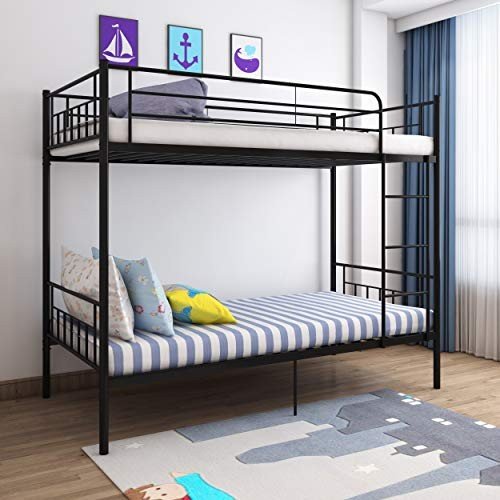Responsible For A Bunk Bed For Kids Budget? 10 Terrible Ways To Spend Your Money

The Ultimate Guide to Bunk Beds for Kids: Safety, Styles, and Solutions
Bunk beds have actually long been a popular option amongst parents seeking to optimize space in their children's bed rooms. With benefits that go beyond their compact design, bunk beds provide a fun and functional sleeping plan while motivating sibling bonding and fostering imagination. In this thorough guide, we explore various elements of bunk beds for kids, including safety considerations, various styles offered, and recommendations for picking the right one for your family.
Why Choose Bunk Beds?
Bunk beds are designed to stack one bed on top of another, using vertical space to develop more space for play and storage. They are particularly beneficial for families with numerous kids or restricted bed room space. In addition, they provide a daring sleeping environment that children frequently enjoy.
Secret Advantages of Bunk Beds:
- Space-saving style: Ideal for small spaces or shared spaces.
- Cost-efficient: Often more inexpensive than purchasing 2 different beds.
- Encourages social interaction: Promotes bonding amongst siblings or friends.
- Flexible alternatives: Available in different designs and configurations to match any space design.
Security First: Essential Considerations
When picking a bunk bed for kids, safety should be the leading priority. The following functions are essential for ensuring a safe and secure sleeping environment:
Important Safety Features:
- Sturdy Construction: Ensure that the bed frame is made from durable materials such as solid wood or metal.
- Guardrails: Bunk beds should have guardrails on both sides of the upper bunk to prevent falls.
- Ladder Safety: A sturdy, integrated ladder or stairs with anti-slip rungs is necessary for safe access to the top bunk.
- Weight Limit: Check the maker's weight limitation capacity for both the top and bottom bunk.
- Mattress Size: Use the correct mattress size as defined by the bed producer to ensure a snug fit within the bed frame.
Safety Tips for Parents:
- Monitor Sleep Habits: Teach kids the significance of not playing on or leaping off the bunk beds.
- Age Appropriateness: Generally, the upper bunk is suitable for kids aged 6 and older.
- Routine Inspections: Periodically examine for any loose bolts, screws, or structural damage.
Styles of Bunk Beds
Bunk beds can be found in a variety of styles, enabling moms and dads to select one that complements their kid's space decoration while conference particular requirements. Below are some popular styles:
Popular Bunk Bed Styles:
- Traditional Bunk Beds: Simple and traditional styles made of wood or metal with no extra features.
- Loft Beds: Features a raised top bunk with space beneath for a desk, play location, or additional storage.
- L-Shaped Bunk Beds: Arranged in an L-shape, typically ideal for corner spaces and can have additional storage alternatives.
- Twin over Full Bunk Beds: A twin bed on leading and a larger full-sized bed on the bottom, accommodating children or teens of different ages.
- Triple Bunk Beds: Designed to fit 3 beds in a single footprint, ideal for larger families or slumber parties.
A Comparison of Bunk Bed Styles
| Bunk Bed Style | Description | Best For |
|---|---|---|
| Conventional | Timeless design with two stacked beds | Standard bed room setups |
| Loft Bed | Raised bed with usable space underneath | Homework or play locations |
| L-Shaped | Bunk beds set up in an L-shape | Corner spaces |
| Twin over Full | Twin bed on top, full bed listed below | Various age siblings |
| Triple Bunk | 3 stacked beds | Large households or pajama parties |
Selecting the Right Bunk Bed
When looking for the ideal bunk bed, think about the following elements to guarantee you make an informed choice:
Key Factors to Consider:
- Room Size: Measure the space dimensions to identify the proper size and height of the bunk bed.
- Child's Age: Consider the age of your kid(ren) when selecting a design and security features.
- Functionality: Think about just how much storage or play space you need and whether the bunk bed must serve additional purposes.
- Spending plan: Set a budget that includes not just the bunk bed however likewise the needed bed mattress and accessories like bed linen or safety gates.
FAQs About Bunk Beds for Kids
1. What age is suitable for a child to sleep in the leading bunk?
Generally, kids aged 6 and older need to be able to securely oversleep the leading bunk, though you ought to constantly consider your kid's maturity level.
2. Are bunk beds safe for young children?
It is not suggested for young children or extremely children to sleep in the leading bunk due to the threat of falling.
3. How do visit the up coming site keep the bunk bed?
Examine the bed regularly for any signs of wear and tear, tightening up screws, and cleaning up the mattresses to guarantee extended safety and resilience.
4. Can I transform a bunk bed into two different beds?
Numerous bunk beds are created to be convertible, allowing you to separate the beds when needed. Check the maker's requirements before buying.
5. How can I make the most of space in a bunk bed room?
Use under-bed drawers, shelves, or lofted designs to create additional storage services in a space with a bunk bed.
Bunk beds use a wonderful mix of enjoyable, functionality, and space-saving utility, making them a best choice for young families. By thinking about safety features, numerous styles, and practical elements such as space size and age suitability, moms and dads can choose the best bunk bed for their child's requirements. With the ideal choice, bunk beds can change a bedroom into a magical space that encourages play, creativity, and bonding amongst brother or sisters. Always remember to focus on safety and upkeep to take advantage of this unique sleeping plan.

